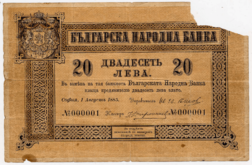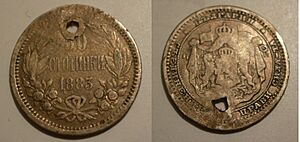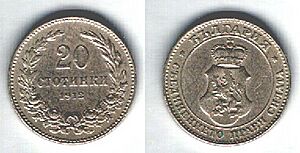Bulgarian lev facts for kids
Quick facts for kids Bulgarian lev |
|||
|---|---|---|---|
|
|||
| ISO 4217 Code | BGN | ||
| User(s) |
|
||
| Inflation | 14.3% (2022) | ||
| ERM | |||
| Since | 10 July 2020 | ||
| € = | BGN 1.95583 | ||
| Band | 15.0% de jure; 0.0% de facto | ||
| Pegged with | Euro (€) = 1.95583 leva | ||
| Subunit | |||
| 1⁄100 | stotinka | ||
| stotinka | ст. (st.) | ||
| Nickname | kint | ||
| Plural | levove, numeric: leva | ||
| stotinka | stotinki | ||
| Coins | 1, 2, 5, 10, 20, 50 st., 1 lev, 2 leva | ||
| Banknotes | 5, 10, 20, 50, 100 leva | ||
The lev (Bulgarian: лев) is the official money of Bulgaria. The word "lev" used to mean "lion" in old Bulgarian. Today, the word for lion is lаv (лъв). One lev is divided into 100 stotinki (стотинки). The word "stotinka" means "a hundredth" and comes from the Bulgarian word "sto" (сто), which means "a hundred."
Since 1997, the lev has been connected to the Deutsche Mark (the old German currency) at a fixed rate. When the euro was created, the lev became fixed to the euro. This means that 1 euro is always worth 1.95583 Bulgarian leva. Since 2020, the lev has been part of a special system called the European Exchange Rate Mechanism (ERM II). Bulgaria plans to join the Eurozone and start using the euro when certain economic conditions are met.
Contents
What Does "Lev" Mean?
The name of Bulgaria's money, "lev," comes from an old Bulgarian word for lion.
The lion has been an important symbol for Bulgaria for many centuries. You can see lions in many historical places in Bulgaria. Some of the oldest pictures of lions are from the 9th and 10th centuries AD in the city of Stara Zagora. A lion is also carved into the famous Madara Horseman, a huge rock carving in northeastern Bulgaria that is a UNESCO World Heritage site. In the Middle Ages, Bulgarian kings like Ivan Shishman used the lion as a sign of power.
During the time when Bulgaria was under Ottoman rule, the lion became a strong national symbol. A famous monk named Paisii of Hilendar wrote in his important book that Bulgarian kings had a lion on their royal seal. This lion showed the bravery and strength of Bulgarian warriors, who fought "like lions."
Lions were also shown on the flags used by Bulgarian rebels during the 1876 April Uprising. These flags often had a golden lion standing up, with the words "Freedom or Death." Many of these flags were handmade and are now kept in Bulgarian museums. They were usually green silk with a painted or embroidered lion stepping on the Crescent, which was a symbol of the Ottoman Empire. You could also see lion images on rebel clothes, like hats and buttons. In old Bulgarian stories and writings, these lion pictures were called "lion signs" and were linked to the brave Bulgarian revolutionaries.
History of the Lev
The First Lev (1881–1952)
The lev was first used as Bulgaria's money in 1881. Its value was the same as the French franc. For a while, Bulgaria's silver and gold coins were made to the same standards as other European countries. Until 1928, banknotes were backed by gold or silver.
During World War II, in 1940, the lev's value was fixed to the German money (Reichsmark). Later, after the Soviet army arrived in 1944, it was fixed to the Soviet ruble. Then, it was fixed to the U.S. dollar several times. After 1943, only banknotes were printed until a big change in the currency happened in 1952.
Coins of the First Lev
Between 1881 and 1884, coins for 2, 5, and 20 stotinki (made of bronze) and 50 stotinki, 1, 2, and 5 leva (made of silver) were made. Later, in 1888, coins for 2.5, 5, 10, and 20 stotinki were introduced. Gold coins for 10 and 20 leva were made in 1894.
Making silver coins stopped in 1916. In 1923, new 1 and 2 leva coins made of aluminum were introduced. In 1930, silver coins for 20, 50, and 100 leva were made until 1937. The last coins for this version of the lev were made in 1943.
Banknotes of the First Lev
In 1885, the Bulgarian National Bank started printing banknotes. At first, they made notes for 20 and 50 gold leva, and later for 100 gold leva. In 1899, notes for 5, 10, and 50 silver leva were issued.
After 1928, a new series of notes was introduced that just showed the value in "leva" without saying "gold" or "silver." These included values like 5, 10, 20, 50, 100, 500, 1000, and 5000 leva. Coins later replaced notes up to 100 leva.
The Second Lev (1952–1962)
In 1952, after a lot of inflation (when prices go up very fast), a new lev was introduced. One new lev was worth 100 old leva. The new lev was fixed to the U.S. dollar at first.
Coins of the Second Lev
In 1952, new coins were made for 1, 3, 5, 10, and 25 stotinki. Later, 20 and 50 stotinki coins were added, and a 1 lev coin in 1960. All stotinki coins showed a head of wheat, and the lev coin had an olive branch design.
Banknotes of the Second Lev
In 1952, new banknotes were issued for 1, 3, and 5 leva by the state, and for 10, 25, 50, 100, and 200 leva by the National Bank. The 1, 3, and 5 leva notes showed the state symbol. Higher value notes (10 leva and up) featured Georgi Dimitrov, a famous Bulgarian leader.
The Third Lev (1962–1999)
In 1962, the lev was changed again. This time, 1 new lev was worth 10 old leva. The value was set at 1.17 leva for 1 U.S. dollar. This lev stayed quite stable for almost 30 years. However, it was not easy to exchange it for Western money, so black market rates were much higher. Until 1989, the banknotes stated that they were "backed by gold and all assets of the bank."
After the end of communism, Bulgaria faced very high inflation and its money lost a lot of value. To fix this, in 1997, the lev was fixed to the Deutsche Mark (German money) at a rate of 1,000 leva to 1 Deutsche Mark. Since 1997, all Bulgarian money in use has been fully backed by the foreign money reserves held by the Bulgarian National Bank.
Coins of the Third Lev
In 1962, new coins were introduced for 1, 2, and 5 stotinki (made of aluminum-bronze) and 10, 20, and 50 stotinki, and 1 lev (made of nickel-brass). These coins looked very similar to Soviet Union coins from the same time. The state symbol was on the front of all coins, and it changed a few times over the years.
Banknotes of the Third Lev
In 1962, the National Bank issued notes for 1, 2, 5, 10, and 20 leva. A second series was issued in 1974. In 1990, 50 leva notes were introduced. Again, notes 10 leva and up featured Georgi Dimitrov, while lower values showed the state symbol. After communism ended, new notes were introduced for 20, 50, 100, and 200 leva. Later, even higher values like 500, 1000, 2000, 5000, and 10,000 leva were printed because of inflation.
The Fourth Lev (1999–Present)
On July 5, 1999, the lev was changed again. This time, 1 new lev was worth 1,000 old leva. The new Bulgarian lev is known by the code BGN. It was fixed to the Deutsche Mark at a 1:1 rate. When the Deutsche Mark was replaced by the euro, the lev's value became fixed to the euro at 1 euro = 1.95583 leva. This rate is expected to stay the same until Bulgaria starts using the euro.
Joining the Euro
Since Bulgaria joined the European Union in 2007, there have been talks about when it will start using the euro. The plan is for Bulgaria to use the euro two years after it joins the European exchange rate mechanism (ERM II). On July 10, 2020, Bulgaria joined the ERM II, which means it could adopt the euro no earlier than two years after that date, if it meets all other requirements.
Coins of the Fourth Lev
In 1999, coins for 1, 2, 5, 10, 20, and 50 stotinki were introduced. A 1 lev coin replaced the 1 lev banknote in 2002, and a 2 lev coin replaced the 2 lev banknote in 2015.
Banknotes of the Fourth Lev
In 1999, banknotes were introduced for 1, 2, 5, 10, 20, and 50 leva. In 2003, 100 leva notes were added. The 1 and 2 lev notes were later replaced by coins and taken out of use.
See also
- Bulgaria and the euro
- Commemorative coins of Bulgaria
- Economy of Bulgaria






